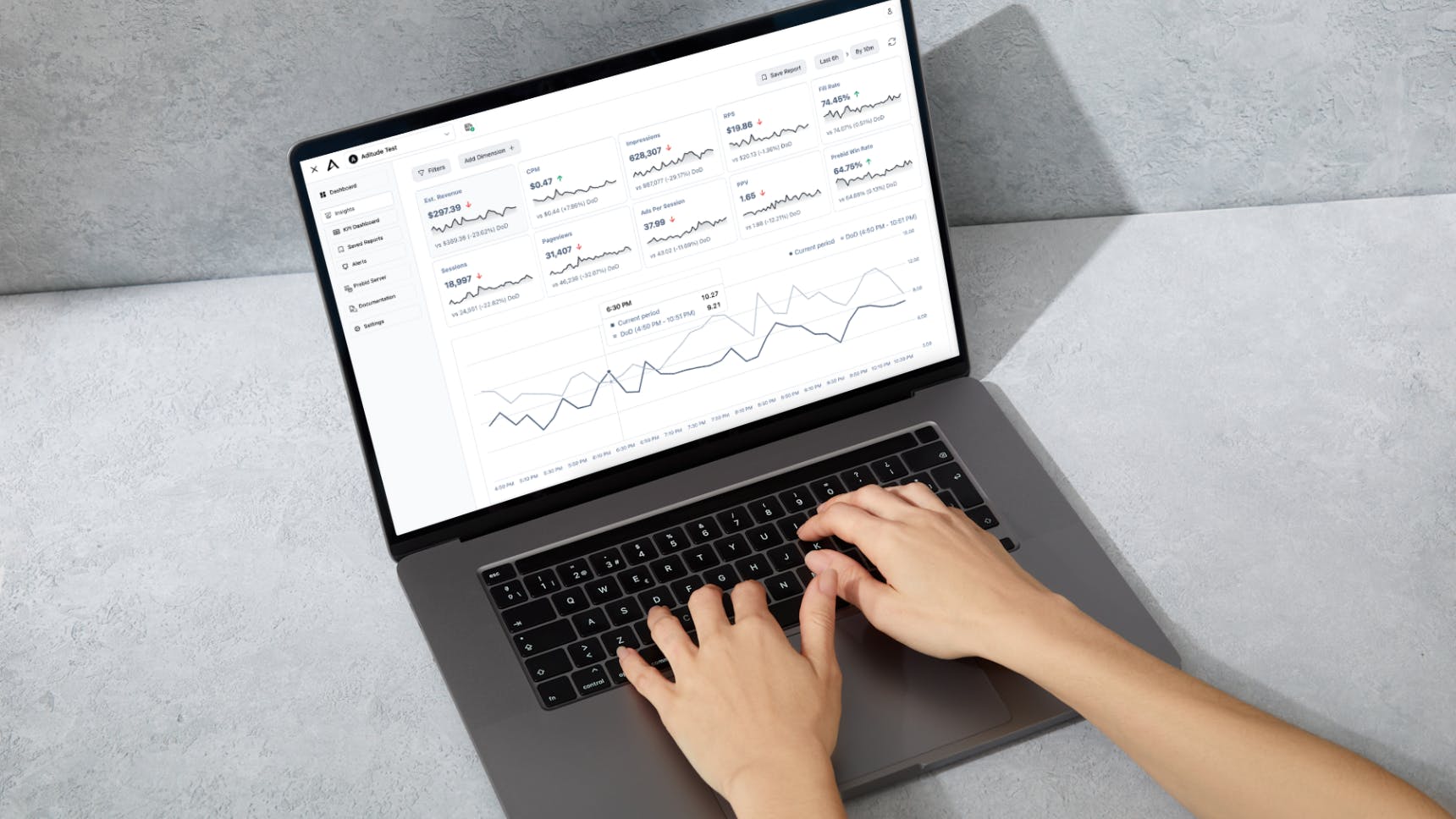Stop Playing Revenue Roulette: How Smart Alert Notifications Save Publishers

It's 11:47 AM on a Tuesday. Sarah, a senior ad ops manager at a large publisher, gets a Slack notification: "RPS dropped 57% in the last hour."
She opens her laptop. Two minutes later, she's sending Slack messages to her ad ops vendor, who's already investigating based on the same alert. Together, they quickly identify the culprit: a server issue causing ad requests to timeout. Her engineering team deploys a fix within 15 minutes. Total revenue impact? Minimal. Without that alert? She might not have noticed until the daily revenue report hit her inbox the next morning—after thousands of dollars had already evaporated.
This is the difference between reactive damage control and proactive revenue protection. And in programmatic advertising, where every impression counts and margins are tight, that difference isn't just significant—it's existential.
The Invisible Revenue Leak
Here's the uncomfortable truth about publisher ad operations: your revenue could be bleeding right now, and you probably wouldn’t know it.
You can't watch dashboards 24/7. Even the most dedicated ad ops teams need to sleep, attend meetings, and occasionally focus on strategic work instead of staring at metrics. Critical drops happen during lunch breaks, overnight, on weekends—precisely when you're not looking.
Generic monitoring creates alert fatigue. Many publishers rely on basic uptime monitors or analytics platforms that send dozens of notifications daily. Get 50 alerts about minor fluctuations, and you'll start ignoring the one that actually matters. It's the boy who cried wolf, except the wolf is eating your quarterly revenue targets.
By the time you notice significant revenue drops through standard reporting, the damage is already done. Most publishers discover problems through end-of-day reports or weekly performance reviews. That's like checking your bank account once a month and wondering where all the money went. In programmatic advertising, where bidding happens in milliseconds and user behavior shifts by the hour, yesterday's problem is already yesterday's lost revenue.
Perhaps most critically, teams miss optimization opportunities because they're stuck in reactive mode. When you're constantly firefighting, you never have time to build firebreaks. Real growth comes from proactively identifying what's working and scaling it—but that requires intelligent systems watching your performance with nuance and context.
The Smart Alert Advantage
Not all alerts are created equal. The difference between noise and intelligence comes down to how sophisticated your monitoring system actually is.
Custom thresholds based on your normal performance separate signal from noise. Aditude's Insights platform learns your unique traffic patterns, seasonal variations, and historical performance to establish what "normal" actually means for your specific business. An RPS drop that would be catastrophic for one publisher might be completely expected for another during certain dayparts or seasons. Industry averages are useless—your business isn't average, and your alerts shouldn't be either.
Smart context tells you exactly what changed and when. A good alert doesn't just say "something is wrong." It tells you which metric triggered the alert, the exact threshold that was breached, and the timestamp when it happened. From there, you can quickly dive into your Insights dashboard to investigate the underlying cause—whether it's a specific bidder, device type, geography, or timeout issue. That's the difference between spending two minutes identifying a problem and spending two hours wondering if there even is one.
Real Scenarios, Real Saves
Theory is interesting. Reality is profitable. Here's what intelligent alerting looks like in practice.
The Code Change Catch: A publisher deployed what seemed like a minor site update. Within minutes, Insights detected an anomaly in refresh rates—ad slots weren't refreshing properly, cutting potential impressions by 40%. The alert went out immediately. The ad ops team identified the conflict between the new code and their existing ad implementation. Rollback happened within 30 minutes.
The Server Failure Sprint: At 4:42 PM, RPS started plummeting for a major gaming publisher. The Insights platform detected the drop and sent alerts through multiple channels. The on-call engineer was notified within 60 seconds of the threshold breach. The issue? The publisher's primary ad server had failed over to backup infrastructure that wasn't properly configured. Because the alert included specific metrics showing exactly when and how the drop occurred, diagnosis was nearly instantaneous. The server was back online by 5:15 PM. Without intelligent alerting, this would have been discovered during the next day—after losing an entire night's revenue from peak gaming traffic.
The Certificate Catastrophe: Last July, something remarkable happened that illustrates both the power of intelligent monitoring and the vulnerability of the programmatic ecosystem. At 12:00 AM UTC on July 31st, an SSP’s Consent Management Platform (CMP) went completely dark across thousands of publisher sites. The cause? An expired SSL certificate—a preventable, mundane technical failure with catastrophic financial impact.
Here's what made this different: Aditude's publishers weren't scrambling in the dark. The Insights platform had a real-time down detector for all critical third-party ad code, alerting teams within 60 seconds of the service disruption. While countless publishers across the web watched their monetization disappear with no idea why, Aditude's clients received immediate notifications with context: "Third-party CMP service unavailable as of 12:01 AM UTC."
But alerts alone aren't enough when critical infrastructure fails. Aditude had already developed a self-hosted backup version of SSP’s CMP, ready to deploy the moment the primary service went down. Publishers stayed live. Ads kept serving. Revenue kept flowing. By the time the SSP resolved the issue at 2:23 AM UTC, Aditude's publishers had experienced minimal disruption to what could have been hours of complete monetization failure.
Think about the math: a mid-sized publisher earning $500 per hour would have lost over $1,200 during that outage. Scale that across multiple sites and multiple time zones, and you're looking at five-figure losses from a single certificate renewal that someone forgot to calendar. The SSP didn't even know about the problem when Aditude's alerts went out—external monitoring caught the issue before the vendor's internal systems did.
The ROI That Writes Itself
Let's talk numbers, because in ad ops, everything ultimately comes down to revenue.
A publisher earning $50,000 monthly in programmatic revenue generates roughly $2,083 per day, or about $87 per hour. A single undetected issue lasting just four hours costs $348. Miss a major overnight problem that goes unnoticed for eight hours? That's nearly $700 gone.
The cost for intelligent alerting through Insights is a fraction of what you lose from a single missed revenue incident. One prevented outage pays for months of monitoring. Two or three saves per year, and the platform has essentially paid for itself multiple times over.
But the real ROI isn't just prevented losses—it's the optimization opportunities you can finally pursue. When you're not constantly firefighting, your team can focus on strategic improvements: testing new bidders, optimizing floor prices, improving ad layouts, and analyzing what's actually driving incremental revenue. The platform's analytics capabilities extend beyond alerting to comprehensive performance insights that inform strategic decisions.
One Aditude client described the shift this way: "Before Insights, we spent 70% of our time investigating problems we'd already discovered too late, and 30% trying to grow. Now it's reversed. The alerts catch problems before they become expensive, and we actually have time to be strategic about our business."
Stop Playing Defense With Your Revenue
The publishers winning in today's programmatic landscape aren't the ones with the biggest teams or the most traffic. They're the ones with the best systems—the ones who've automated the defensive work so humans can focus on strategic offense.
Every minute you spend manually checking dashboards is a minute you're not spending optimizing your business. Every revenue drop that goes unnoticed for hours is money you'll never get back. Every optimization opportunity you miss because you're stuck in reactive mode is growth you're leaving on the table.
Smart alerting isn't about adding more notifications to your day—it's about replacing noise with signal, replacing generic thresholds with personalized intelligence, and replacing reactive firefighting with proactive revenue protection.
The question isn't whether you can afford sophisticated monitoring. It's whether you can afford to keep flying blind.
Stop playing revenue roulette. Let smart alerts watch your business while you build it.
Ready to see how intelligent alerting protects and grows programmatic revenue? Learn more about Aditude Insights and request a demo at aditude.com/insights.



